Monitors or TVs usually come with built-in speakers. However, if yours doesn’t have one, you might want to connect an external speaker to the display.
Well, it’s better to connect the speakers to suitable PC interfaces if you’re using a computer monitor. But if you’re using it as a TV or having trouble with the internal speakers, you’ll be glad to know that the monitors support external speakers.
Unfortunately, not all displays have built-in audio-out ports. , and you may need other adapters or converters to make it work. As such, this article walks you through the five simple yet effective ways to connect speakers to a monitor.
Things to Consider
Before learning how to connect speakers to a monitor or It is essential to keep a few things in mind.
First, speakers can be active or passive. Basically, the passives have dedicated cables to plug into the amplifiers before establishing a connection to the monitor or other devices. Active speakers, on the other hand, have a pre-installed amplifier and can therefore be connected directly to the monitor.
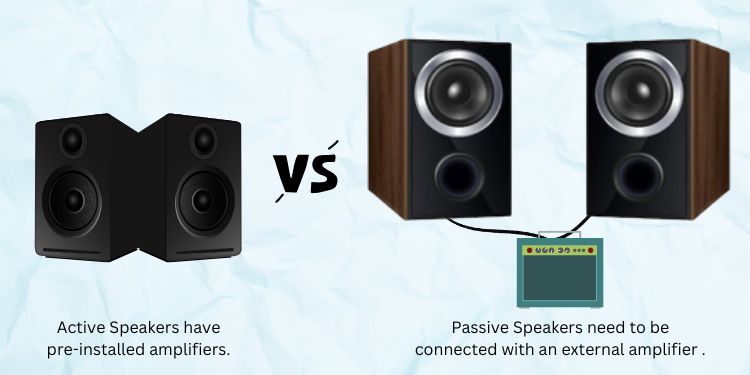
Second, you should be aware that monitors may have input and output ports for transmitting audio signals. While the input ports receive signals from other sources, the output ports are meant to send signals to your speaker.
Therefore, you should check if your monitors have audio output ports dedicated speakers if you want to connect external speakers. Modern displays usually come with digital ports (optical out, HDMI ARC), while some may also have analog ports (RCA OUT, AUX).

Sometimes the audio interfaces of monitors and speakers do not match. In this case, you must use suitable adapters or converters. For example, if your speaker needs an RCA connection and your monitor only has an AUX port, you can use an RCA to AUX converter.
Similarly, if your speaker has an analog audio interface, but the monitor has a digital one, you will need a digital-to-analog audio converter. Similarly, a speaker with a digital interface and a display that has an analog audio output requires an analog-to-digital audio converter.
How do I connect the speakers to a monitor or television?
Typically, most monitors have built-in speakers. In fact, if you use a TV as a computer monitor, you can easily play sound through it instead of needing an external speaker.
However, not all internal speakers can meet your expectations. So an external audio output device is great if you want amplified sound or want to add more bass.
So, you can refer to this section to learn how to connect an external speaker to your display device.
Direct Connection Using Built-in Ports
If your monitor or TV has built-in audio out ports, you can directly connect the external speaker and it should work fine.
Now that you know the various audio output ports on a monitor, you can identify the right one for you and refer to the following guide on how to connect your speakers to your display:
- First, take the appropriate cable. For example, take the 3.5mm male jack if both the monitor and the speaker have the AUX port.
- Now, carefully tilt or turn the monitor to >access the rear panel ports.
- Find the correct audio output port (for example, AUX OUT) and insert the connector, making sure it that the connection is strong.
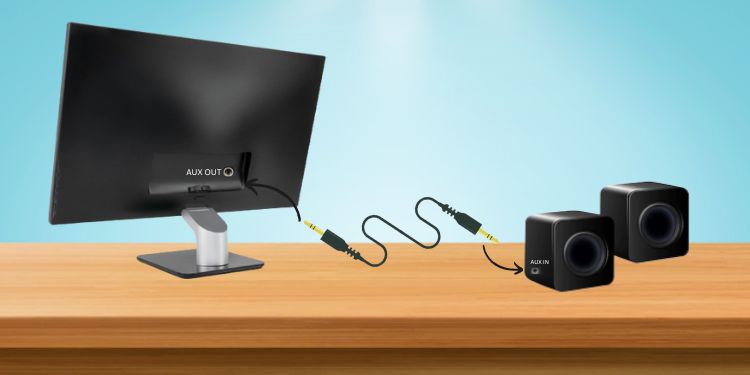
- Now, take the male connector from the other end and connect it to the audio input port of the speaker (AUX IN).
Well, the audio device should start working as soon as you plug it into the monitors, regardless of which port you use. If the speaker does not work, you can manually select the correct model and see if this solves your problem:
- Click the speakers icon in the system tray under Windows Taskbar.
- Then select the Manage Audio Devices icon next to the volume slider.

- Here, choose your connected speaker and see if it works now.
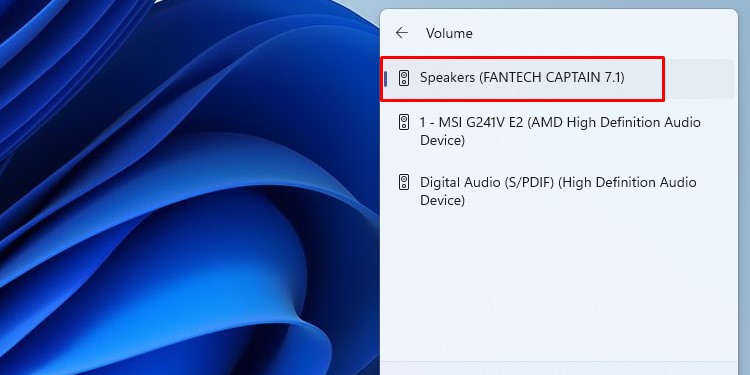
Connect via Bluetooth
If your smart TV or monitor supports Bluetooth, you don’t need a cable to connect to one or more Bluetooth speakers.
But if you’re not sure if your display device supports wireless technology, you can check your monitor’s manual, and you can explore the monitor’s settings using a button dedicated, usually present on the bottom or rear of the device.
Now, you can follow the instructions below on how to connect Bluetooth speakers to your monitor:
- First, turn on the external speaker by connecting it to the power supply.
- Then make sure Bluetooth is enabled. Well, the setting is different on different speaker models. You can try long pressing the power button. on, which usually makes the device v isible.
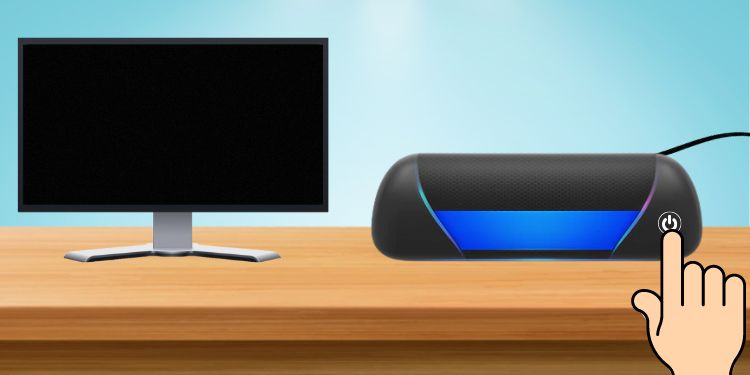 If not, check the dedicated manual to see what works for your device.
If not, check the dedicated manual to see what works for your device. - Now, switch to the monitor screen and, using the dedicated button Please enable Bluetooth here as well.
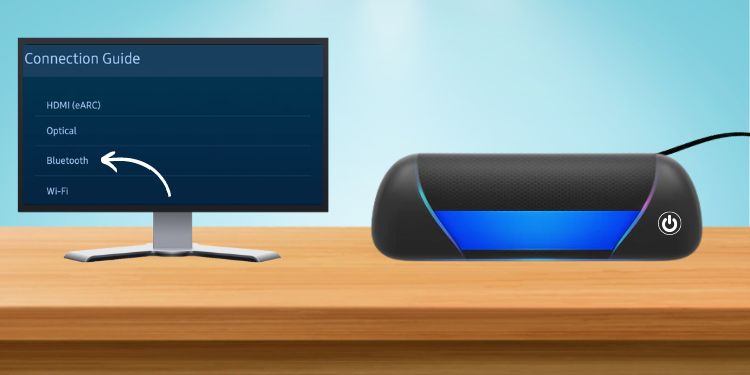
- You should get a list of available devices. Here, choose your speaker and the connection should be successful.
Using the right adapters and converters
If the audio ports on your speaker and monitor do not match, we recommend that you obtain a suitable adapter.
For demonstration purposes, let’s say the speaker only has an AUX input port while the monitor does not have an AUX output port. In this case, you can use the RCA OUT port and connect the speaker via an AUX to RCA adapter:
- First, plug the AUX male connector into the AUX IN port from the external audio device.
- Then, insert the white and red RCA connectors into the white and red RCA OUTPUT ports of the monitor. Well, you can skip the yellow connector since it carries the video signal.
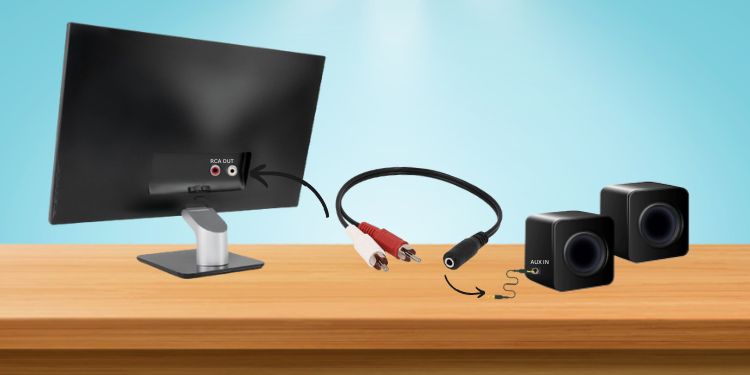
- Then connect it to a power source and check if the audio is coming from the monitor or external speakers.
However, if the audio device supports AUX (analog) but If your monitor only has digital audio output ports (USB, TOSLINK, HDMI ARC, etc.), you will need to use a digital-to-analog audio converter:
- First, make sure that both the converter and speaker are connected to the power supply.
- Now, insert the first end of the TOSLINK cable into the input port of the converter and the other end into the of the monitor. TOSLINK interface.
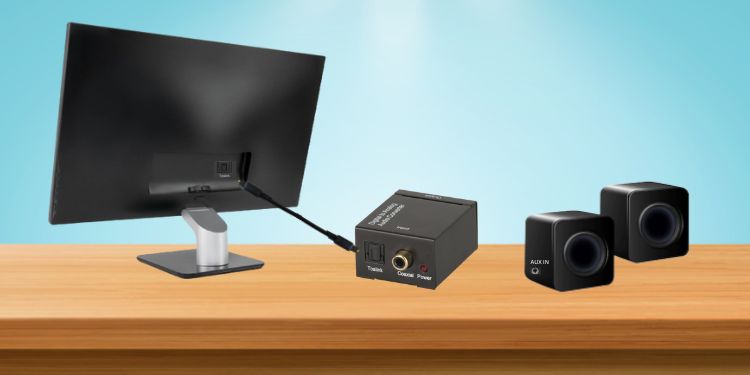
- In the same way, plug the first end of the 3.5 mm cable (AUX jack) into the output port or Connect the converter and the other end to the AUX IN port of the speaker.

- Finally, play music or play a video to check if the speaker is working.
Using the USB Audio Card
USB audio cards, or also known as sound cards, use the USB ports of a device and have LINE-IN and LINE-OUT ports for connection of external speakers.
Clearly, this means that audio cards o They are applicable only to those monitors and audio devices with USB and AUX ports. However, using it significantly improves sound quality by preventing static noise from the speaker.
Follow the steps below on how you can use USB audio cards to establish a connection between your monitor and a external speaker :
- Connect your speaker to the power supply.
- Then, insert the USB audio card into the monitor’s USB port.
- Now, connect the 3.5mm audio cable to the output port of the speaker and to the AUX-IN of the sound card >.

- Finally, play any video to confirm that sound is coming from the connected external audio device.
Using HDMI Audio Extractor
Since most of modern monitors come with at least one HDMI output port, the HDMI Audio E xtractor is useful for connecting an external speaker. In addition, this component consists of L/R OUT and Optical Out ports, so most speakers are also compatible.
Here is a complete guide on how to use HDMI Audio Extractor to establish a connection between a monitor and a speaker:
- First, make sure that both the external speaker such as HDMI Audio Extractor are connected to the power source.
- Now, take an HDMI cable and connect it to the HDMI OUT of the monitor.
- Then, connect the other end of the HDMI cable to the HDMI IN on the extractor.
- Similarly, use an applicable cable (AUX or optical) to connect one end to the >speaker input port and another on the extractor output port.

- Finally, turn on your monitor and you should hear audio from the connected output device.
.
